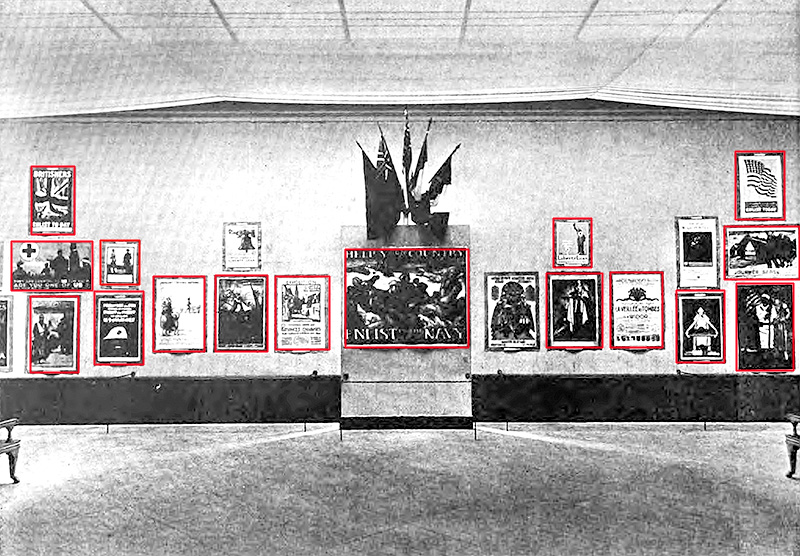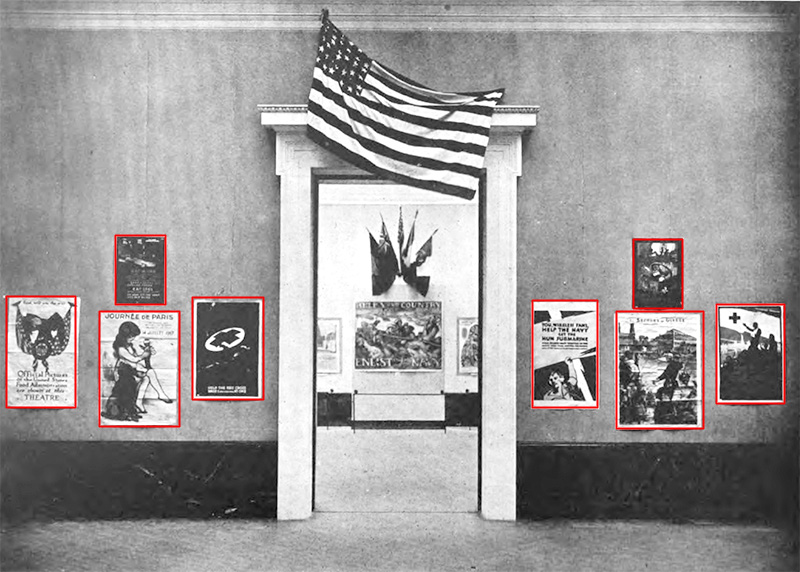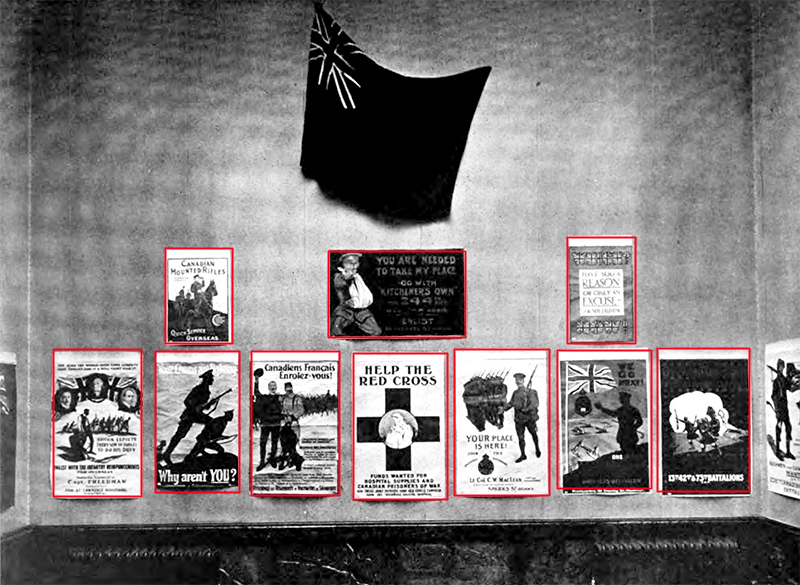Albright Art Gallery Exhibit of War Posters, Drawings and Lithographs
[The text below is by Cornelia Bentley Sage, Art Director of the Albright Art Gallery at the time of this exhibit. It is her description of the exhibit, published in Academy Notes, the quarterly publication of the Buffalo Fine Arts Academy, Albright Art Gallery. Volume XIII January 1918-October 1918.]
The present war has affected many faces of our national life, and art is no exception. In the great task of arousing and informing the people, the artist have been called upon to do their part.
There was held January 12th to February 3rd [1918] at the Albright Art Gallery, a remarkable exhibition of war posters, lithographs and drawings, representing the art of the various allied countries, England, Canada, France, United States and Italy. All of the rooms in the gallery where this patriotic collection was displayed were decorated with the flags of the allies. Over 400 examples of war work were shown.
In the largest gallery was hung the collection of work posters in the Official Exhibit of the Committee on Public Information, Washington, D.C.; The Collection of American Posters organized by Charles D. Gibson and F.D. Casey, Committee on Public Information, New York City; and the collection of War Posters lent by the US Navy recruiting Bureau. Among the artists represented were such men as Howard Chandler Christie, Albert Sterner, Louis Raemaekers, C.B. Falls, Frank Brangwyn, H. Reuterdahl and others of distinction. The work of many of these artists is of course, familiar to us, yet it was inspiring and instructive to have so many examples of it assembled in one building. It was pleasing to note several Red Cross posters done by Buffalo artists and pupils of the art school of the Albright Art Gallery.

Largest Gallery. Click on any red-bordered box to see a larger color version of the poster.
In the place of honor - the center panel - was hung the impressive poster of the great English artist, Frank Brangwyn. Mr. Brangwyn, after eminent service for his own country, has sent some of his best work to aid recruiting on this side of the water. This poster which is in monochrome suggest the loss of the Lusitania and vividly portrays the passengers escaping from a torpedoed ship. Some idea of the extent of this method of recruiting may be gained from the fact that, in the last eight months, the Navy alone has sent out over half a million posters. Raemaekers contributed the forcible “Enlist in the Navy” which represents Uncle Sam taking the cross of militarism and barbarism from exhausted Europe. A splendid work by Blashfield depicts the figure of Liberty armed with the following mottol, “The sword is Drawn, the Navy upholds it.” Another shows in American eagle flying angrily over a submarine about to attack a merchant ship. Albert Sterner was represented by a striking work in color, entitled “Over There.”

Gallery with various posters. Click on any red-bordered box to see a larger color version.
The foreign posters satisfy your desire to know what sort of work the allied countries are doing in this phase of art. The two advertising the activity of the American ambulance in Russia, illustrate the fact that our far-flung relief work is to be found on many fronts. A spirited French appeal for money employs the picture of a gold coin upon which the French cock is overwhelming a Prussian soldier; and there are several others asking aid for relief work among widows and orphans. A picturesque Italian poster represents a soldier of that country urging loans with which to carry on the war. A notable French poster portrays Cardinal Mercier in his robes as the protector of invaded Belgium.

Canadian Posters. Click on any red-bordered box to see a larger color version.
The Canadian war posters show the courage and faith with which the Dominion has called her sons to take part in the war for freedom. Many of these men ask men to join particular battalions and express the personal pride each man has in his own command. A call to arms for the French Canadian is especially interesting; it represents an officer asking for volunteers while near him the French cock is fighting with Prussian eagle. The 148th battalion pictures a lonely fighter, wounded, crying out, “Why don’t they come?” with the vision before him of a group of men at home wasting their time in useless recreation. Canadian posters are to be praised for their artistic form and martial spirit.
The drawings of Vernon Howe Bailey showed his skill as an artist and depicted the wonderful activities of the government in preparations for war. Mr. Bailey had unusual opportunities for studying these industries because the different governments wished the people to understand how seriously they were entering the long struggle. Bailey is a young artist whose technique has already reached a high standard. His wonderful series in illustrations of the munitions plant and shipyards, reveals the picturesqueness of the great guns, cranes, airplanes and battleships. With remarkable fidelity, Mr. Bailey has sketched such subjects as a gun in the process of completion upon a lathe, the construction of a gun mount and a torpedo boat in dry dock. He has expressed well, as secretary Daniels says, “Our tremendous achievements in manufacture and something of the indomitable spirit which enforces the purpose of America.” Among his many excellent drawings, some may be mentioned especially: a battery of field artillery at the Bethlehem factory, airplanes on the government testing grounds, a great converter pouring out the white metal which will soon be taking the shape of guns or shells, and a huge munition carrier nearly ready for service. The lithograph, “Howitzers and Turrets,” is interesting in detail, And the drawing “A Converted Liner” shows busy preparations to make it the vessel ready to carry men and supplies across the seas. Altogether, the sketches of Mr. Bailey are well executed and give a vivid idea of the widespread activities now going on in the United States to ensure the winning of the war.
Joseph Pennell has been known as a creator of pencil sketches of many lands. Spain and other countries have been portrayed in many notable pictures, well a recent phase of the artist’s work has been a series on the Panama Canal. His war lithographs represent the operations of making guns and munitions in the United States and England. He begins at the foundation, depicting the various steps in converting the crude ore into steel bars and ingots and the processes of making them into guns, war vessels, airplanes and projectiles. Among his pictures maybe mentioned “Building Engines for the Allies,” “The Great Hammer” and “The Biggest Lathe in the World.”
The vivid and irresistible cartoons of Louis Raemaekers blazed forth to the world, the intolerable wrongs of Belgium ; these were hung in gallery 13 and proved a center of great interest. Ramaekers, whose father was Dutch and mother German, at the beginning of his career was an unknown writer for a Dutch newspaper. In earlier years he had been a landscape painter. Then came the war with the suddenness of a thunder-stroke, and Raemaekers seemed inspired, his first cartoons inflaming the hearts of the civilized world. His great drawings followed, one after the other, all showing the salient features of the war and turning a searchlight up on German methods of conquest and control. The cartoons soon began to make trouble for the artist; and although he was acquitted of the charge of anti-neutrality, he was later obliged to flee to England, the Germans putting a price on his head. He did not remain continuously in England but spent much time in the trenches and ruined towns of France and Belgium. At present he is in this country because, as he says, the United States is the center of the great struggle. A successful cartoonist must understand thoroughly human nature and the spirit of the times and must have the power of expressing his ideas to stir the people; he must indeed be a leader of men. Raemaekers aims to drive home the truth; he says that his pictures are true to the facts and often he has been unable to put up on paper the worst things he has seen. His work as an intense appeal, reaching the public by the directness and force of his art. Raemakers has received many distinctions; France has enrolled him in the Legion of honor, and London has selected him to her art societies. In the cartoon one notes that the color work is less emphasized then the lines and that the artist has a wonderful power of depicting the emotions. Among the pictures in the collection which have attracted a special attention are these: “Will They Last?”, “Michael, ‘Hurrah for the Kaiser’ ”, And “Kitchener: He Did His Duty to the Last.” [ed. note: unable to locate cartoons with these titles from the hundreds he created during the war.]
A late writer declares, “ The range of Raemakers is the range of the world’s emotion.” He was given power where he had but skill.
In 1919, the Albright Art Gallery continued to exhibit artwork relating to the Great War including an exhibit of French war posters, French artists' work during the war on war subjects, and individual paintings by Childe Hassan, Edwin Howland Blashfield and others. Here is an image of Blashfield's painting "Carry On" as exhibited and the Liberty Loan poster created using it.